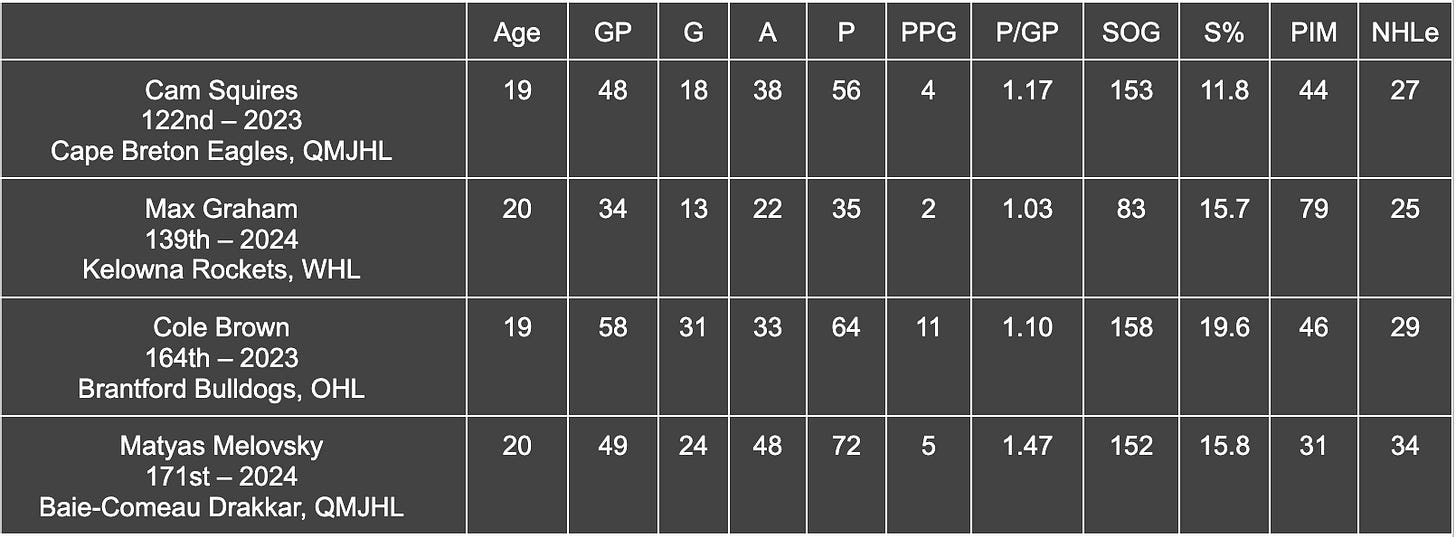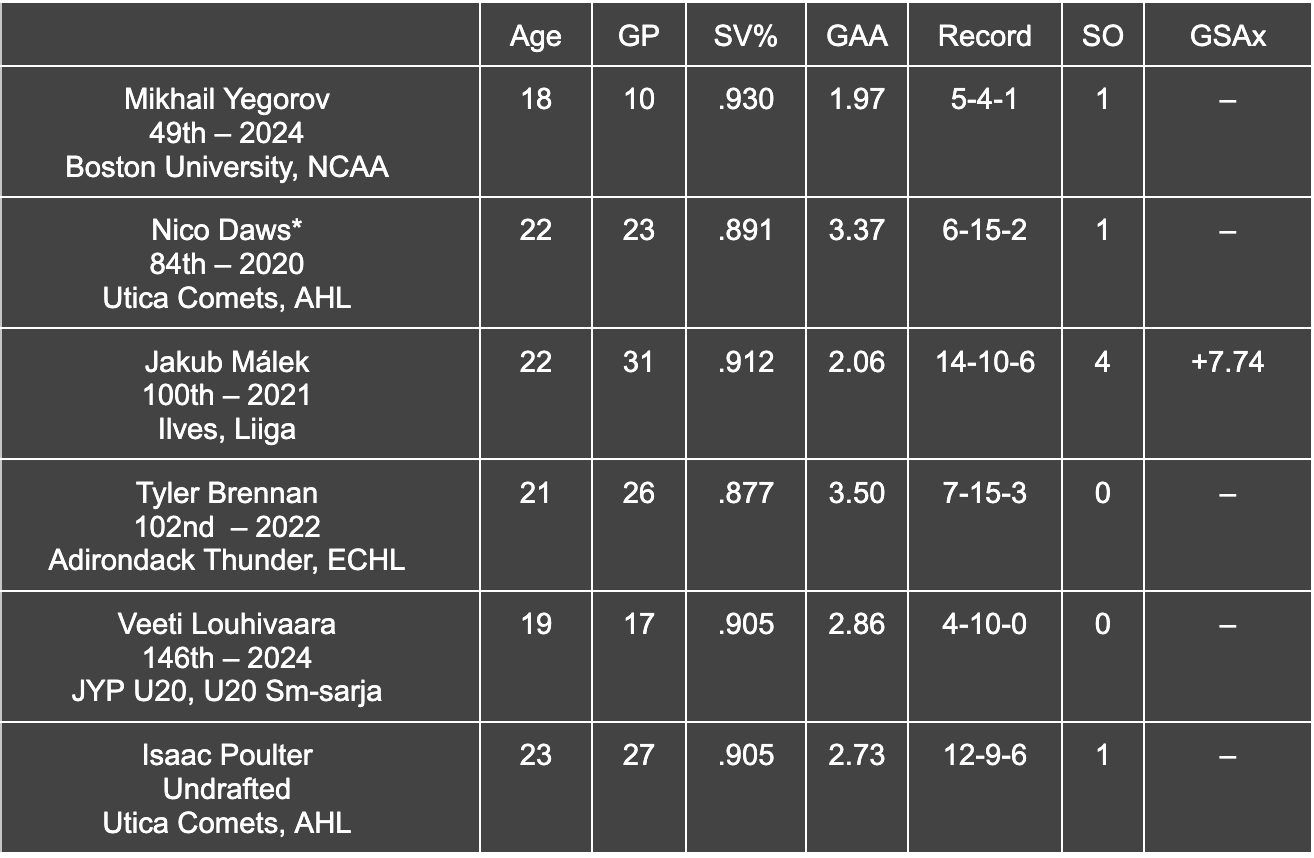I know it’s late in the season, but I think it’s time to start a bi-weekly series covering each and every Devils’ prospect, league by league.
Before jumping into the prospects’ performances, making a few mental notes about the charts you’re about to see is important. Firstly, some of the leagues categorize and track data differently. For example, while most of the leagues have readily available statistics for both power-play goals and power-play assists, some leagues only record power-play goals on their public statistics pages. Some leagues don’t even have public data for metrics as basic as shots on goal.
It’s also important to define NHLe — or NHL equivalency. NHLe is a tool to project a player’s NHL viability through point totals using a mathematical model. Points aren’t everything, but in terms of prospects, they’re the best metric to project success at the NHL level. Each league has a different equivalency — one point in the AHL is certainly not the same as a point in the Canadien Juniors. On that same token, don’t be surprised to see players with similar point productions in different leagues have vastly different NHLe values. NHLe is calculated on an 82-game rate for the NHL.
Next, there’s the matter of how the data is organized. For each league — or conglomeration of leagues — I organized the data into tables with distinct headings: Age, games played (GP), goals (G), assists (A), points (P), power-play points (PPP), points per game (P/GP), shots (SOG), shooting percentage (S%), penalty minutes (PIM), and NHLe. As I previously mentioned, some leagues have power-play goals (PPG) in place of PPP, so keep an eye out for those. Goaltenders are organized into similar tables, with Age, GP, goals-against average (GAA), save percentage (SV%), their records, shutouts (SO), and goals saved above expected (GSAx), if applicable.
The players in their respective leagues are organized by draft order, from highest to lowest drafted. In addition to the tables, I’ll be posting notes highlighting notable players and/or notable performances.
Finally, there’s what I consider to be the “prospect” threshold. I considered every single player in the Devils’ pipeline who is 25 years old or younger. Chances are, if a player is older than that, they’re probably never making the NHL full-time, so I excluded them from the list.
Without further ado, let’s get right into it:
Skaters
Utica Comets (AHL)
Obviously, Šimon Nemec and Seamus Casey are now on the NHL roster, and it’s unlikely that either will return to Utica this season. They have both proved their worth to the organization and are being rewarded with NHL time because of the Jonas Siegenthaler injury.
Chase Stillman is extraordinarily disappointing. Perhaps it’s unfair — the pressure he probably has because of his unwarranted draft pedigree is probably pretty tough to deal with — but he’s been arguably Utica’s worst forward. He’s shown extremely, extremely rare flashes of skill but is largely just a crash-and-bang, fourth-line role player at best. I still think there’s room for him on an NHL lineup in that role, but he’ll only make it because of said pedigree. I feel bad for him.
Adam Beckman has been a pretty nice story since he was swapped for Graeme Clarke. He has some good tools, predominantly his offensive ones. He has a nice release that can beat goaltenders clean and a solid enough hockey IQ to make it in a third-line capacity down the line. He’s got good size — 6’2, 182 pounds — and uses it well enough to fend off defenders with power moves or win the occasional board battle. I wouldn't mind seeing him get a shot as an injury call-up or extra forward.
Nolan Foote deserves another opportunity in the NHL. He played a couple of games early in the 2024-25 season, and he didn’t look out of place whatsoever but didn’t pot any of his several grade-A chances. Down in Utica, though, he’s been their best forward. He’s got a wicked shot and is unafraid of using his frame to his advantage. There is honestly no reason the Devils have Kurtis MacDermid or even Justin Dowling on the main squad over Foote.
Topias Vilén was a nice story in his first season post-draft but has largely tempered out and flatlined as a projectable seventh-defenseman. Fans overseas see him as having more upside than he really does.
NCAA
Samu Salminen has garnered an increased role with the University of Denver this season, moving full-time to center and providing admirable-enough results. He’s been one of college hockey’s most efficient players in the faceoff circle.
Ethan Edwards, meanwhile, has stepped into a gigantic role at the University of Michigan, averaging over 24 minutes per night. Surprisingly, taking over a shutdown role as a sub-6’0 defenseman, he’s played extremely well. He’s sporting career highs across the board.
The star of the Devils’ NCAA pipeline is Artem Shlaine, who will become a college free agent after this season. He went down somewhat recently with a gnarly-looking injury that left him getting stretchered off the ice, but less than a month later, he’s already returned and putting up points. His NHLe is a fair amount higher than what I expected, but he truly has been Arizona State’s most important player this season. He’s logging the most time on ice per game of any forward on that team and is being deployed in all situations. He, like Salminen, is also one of college hockey’s best faceoff men. I genuinely hope the Devils sign him to bolster their center depth in the organization, even if he never turns into anything past an AHLer.
Canadian Juniors (CHL)
The Devils have quietly developed four legitimately solid mid-late-round prospects in the CHL.
While all four players have had solid seasons in their respective leagues — Cole Brown and Cam Squires are legitimate candidates to come over to the AHL next season, where they’ll be easier to gauge and project — Matyas Melovsky has stolen the show in terms of CHL prospects in the system. He’s been the Drakkar’s best player, and I couldn't be happier to have a center prospect with legitimate NHL upside. He’s a physical center, using his body to create plays for his teammates or using power moves to drive the net before potting one home. He recently had a seven-point performance (three goals, four assists) and looks the part of a could-be third-line center.
KHL
For Anton Silayev, I don’t particularly care about the points he’s putting up quite yet. The fact that, at 18 years old, he’s getting meaningful minutes in the KHL means a lot. His first goal of the season came semi-recently, and it was a rush sequence in which he joined the attack. His unearthly skating ability was on full display, which I anticipate will come to fruition more over the next couple of seasons as he earns more playing time with age.
Arseni Gritsyuk’s production, though, I do care about. The 23-year-old will be in North America contributing to the Devils next season, so it’s certainly encouraging to see his production take a steady incline over the past few seasons. What does surprise me is his two power-play goals — with his one-timer, I would have guessed he’d contribute more there, but it’s reassuring to know that the bulk of his production has come at even-strength. I can’t wait for this kid to make the jump next season.
Rest of Europe
Lenni Hämeenaho has looked phenomenal in Liiga this season, putting all qualms about his skating behind him. He’s looked the part of someone who will meaningfully contribute to an NHL middle-six. I love how much he’s shooting the puck, as it is developing that part of his game better than any practice training could do. As his contract is up with Liiga after this season, I would anticipate him making the jump to the AHL in 2025-26.
Poor Kasper Pikkarainen, who played one game in the WHL before going down with a significant, undisclosed lower-body injury. He came to North America for the first time this season, looking to make a name for himself as a physical power winger, but it doesn’t look good, and the word on the streets is that he’s going to miss the rest of the season.
Edit: Pikkarainen is 18 years old.*
Goalies
What Mikhail Yegorov has been able to do since jumping from the USHL to the NCAA is outright remarkable. At 18 years old, he has completely taken college hockey by storm and cemented himself not only as Boston University’s starting goaltender for the next three-plus years but one of college hockey’s best netminders, period. He’s going to stay in college for two more seasons after this one, as most goalies do, but he’ll be in the NHL after that. For my money, he’d be a Hobey Baker candidate if he played the entire season in the NCAA.
Jakub Málek is having yet another strong season in Liiga, being third in the league in SV%, first in GAA, second in shutouts, and ninth in GSAx. When he’s on his game, he looks practically unbeatable. When he’s off, he’s off, but the box score likely looks worse than it is because his team is probably the best shot-suppressing team in Liiga. Look for him to make it over to the AHL after his season is done.
In his limited stint, Nico Daws has shone at the NHL level but has been particularly unimpressive in the AHL. I’m not sure he profiles as more than a third-stringer anymore, even with his strong performances thus far. I could be wrong, but if he is going to have more of a role in the NHL, it won’t be with the Devils.
There you have it: the first iteration of my Devils’ prospect report. Several leagues are wrapping up their seasons in March, so I’m not sure how long this will continue for this season, but it’s certainly something I aim to do from here on out. I hope you enjoyed keeping tabs on all of the Devils’ youngsters.











I'm going to be genuinely upset if Fitz lets either Shlaine or Edwards leave as free agents.